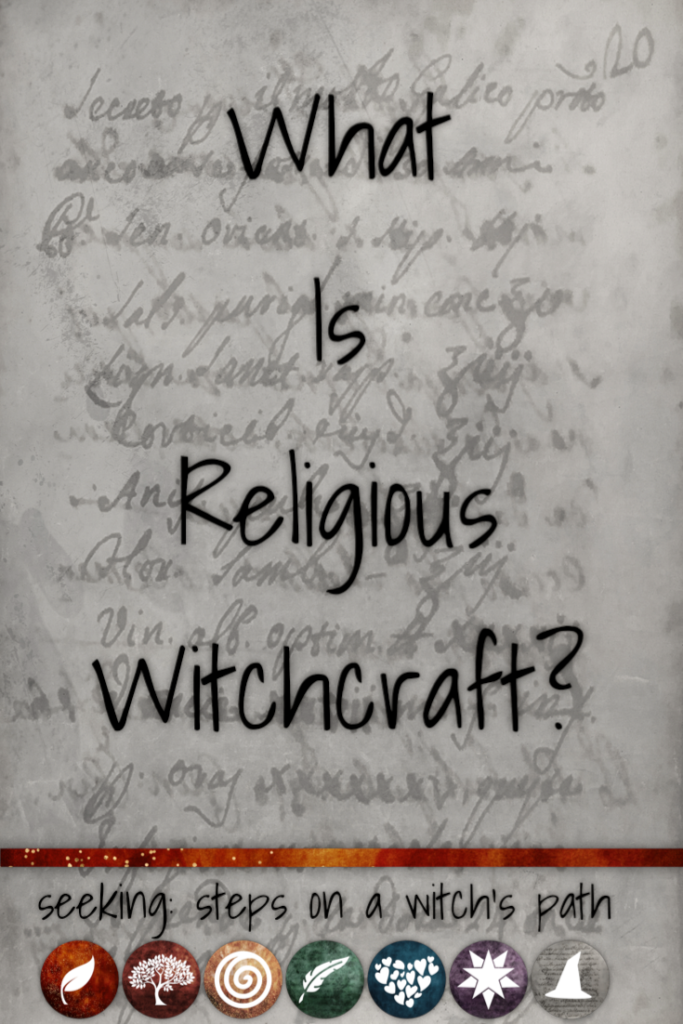Many people hear first about Wicca (a particular form of religious witchcraft) and never realise that there are other variations out there. So, I’m going at it the other direction: talking about the broader options, and then we’ll move on to Wicca (and different ways people use that term.)

Before we go any further, I also want to say that there are many many wonderful groups, teachers, and individual practitioners out there who use these terms in widely varying ways.
My focus here on the terms we use is not about the actual practices themselves. Rather, I want to help people who are looking for a particular thing find it more easily. That might be a kind of practice or likeminded folks to talk to, or advice, or ideas.
There are times when one label makes sense – and there are times when perhaps, a different label might be more informative (part of the reason I tend to refer to my own practice as initiatory religious witchcraft.)
Religious witchcraft practices
Religious witchcraft generally involves some combination of the following, though the forms it can take can be extremely varied.
Use of folk magic (witchcraft)
Common practices include using herbs, food and drink, candles, and other simple tools to focus and direct energy to a particular goal. Many of these uses overlap with medical principles or other practical solutions.
When we talk about folk magic in a witchcraft context, we’re usually talking about that in the European sense of that. The term “witch” in English has a complicated history, but it usually includes both positive practices (like healing or helping the harvest of crops) and negative ones (like cursing).
There are certainly plenty of non-European approaches (and approaches that come from interaction between European and non-European cultures in various ways), but many of those practices don’t call what they do witchcraft. In a number of places, what English translates as “witch” only has very nasty meanings.
My witchcraft tends to focus on physical objects I can do something with. Sometimes that’s candles, sometimes that’s food, sometimes that’s making a piece of symbolic art.
Interaction with deities in some form
Check out the deities page for more on this, but some paths work with a specific deity. Some work solely with goddesses. Some work solely with male gods. Some work with a single male and single female deity. Some work with an entire pantheon from a specific culture, or with deities from several different pantheons. There are numerous other variations.
I honour and work with a variety of different deities. Most of the time, that’s the two I have chosen to focus on, and four deities central to my witchcraft tradition. Depending on my goals, my areas of interest, and other aspects, I might honour and invite other deities to my ritual, or make offerings to them.
Some recognition of cycles
These can be cycles of the seasons (winter, spring, summer, autumn), or they can be cycles of self-transformation. In some paths, they might be a cycle based on the core myths or stories that path honors.
I follow the Wheel of the Year along with some personal dates of interest. My tradition’s wheel is focused more on self-transformation and development than agricultural cycles, but we do pay attention to what’s going on in the world around us.
Shared practice more than shared belief
This is actually true of most Pagan religions. It may help to think of it a bit more like Judaism than like Christianity, in this sense: you’re a good Jew in Judaism because you do the stuff that Judaism says to do, rather than because you believe the right things.
I’ll be talking more about what this actually looks like in practice in a bit, but there’s a certain amount of history we’ve got to get through in order for the spectrum thing to make sense.
A pause for some history:
There are a number of different evolutionary trees. The one we’ll be discussing in depth (Wicca), starts with its roots in British folk practice (with smidgens from all sorts of other places). There are Italian religious witchcraft practices (Strega), and there are traditions like Feri which have their roots in Appalachian and Hawaiian influence, plus some other stuff.
There’s also a significant set of offshoots influenced in various ways by the feminist spirituality movement. The two best known are Dianic witchcraft (sometimes also called Dianic Wicca, though this hits the definitional issues I’ll be talking about later). Most forms of this are either women-only or women-centered.
The other well-known option is Reclaiming, which has some Feri roots, but has gone in a much more politically-focused and centered direction. Reclaiming groups work by some form of consensus, but welcome pretty much any gender identification out there.
Wicca is by far the best known for a bunch of reasons that I won’t go into here: suffice it to say that it’s what sells more books, shows up on more TV shows, and so on than the less well-known ones. Because of that, the term has a fair amount of pull. Some of that is simplicity. (I grant, “I’m Wiccan” is easier than “Well, sort of Wiccan, but …”) And some of it is a desire to belong to a broader group that overrules whether or not the term is actually the best fit.

Revised July 19, 2020



